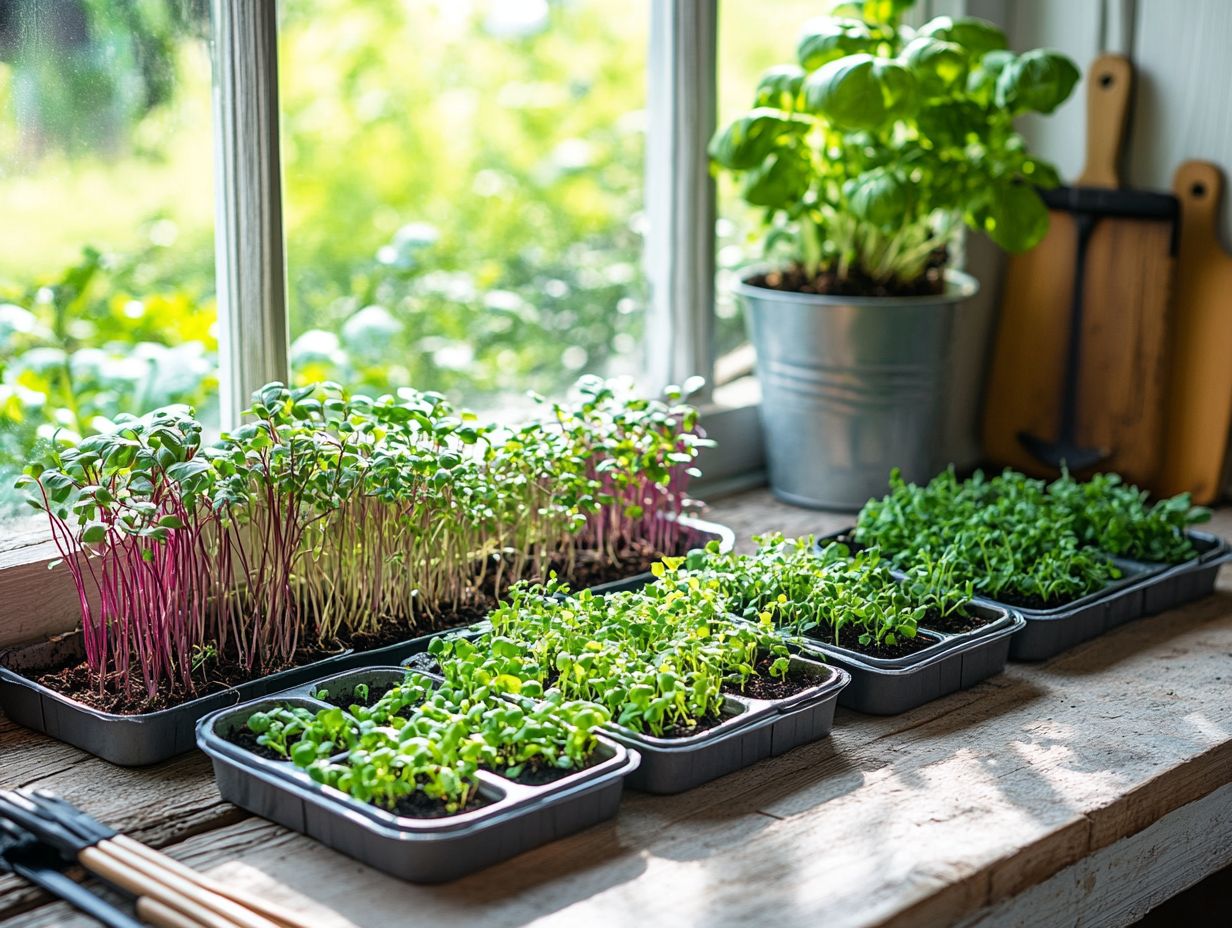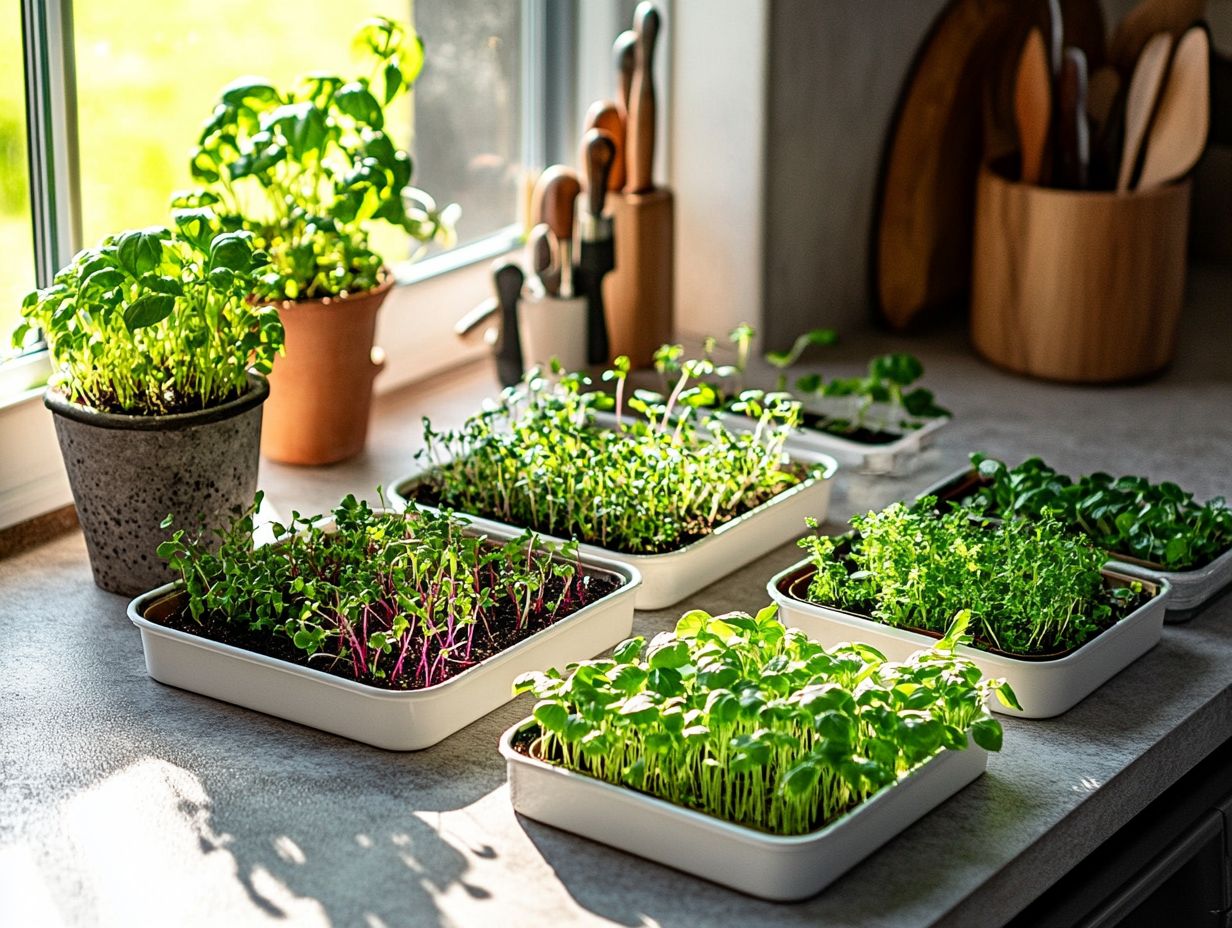Seasonal Microgreen Varieties for Year-Round Growth
Microgreens are delightful, nutrient-dense plants that elevate meals and boost health.
Growing them year-round offers many benefits, from impressive nutrition to cost savings on groceries. There s a microgreen to suit every season, whether winter greens or vibrant summer varieties.
This guide will walk you through the best types to grow, essential supplies, and techniques for success with these little powerhouses.
Get ready to dive into the exciting world of microgreens!
Contents
- Key Takeaways:
- Benefits of Growing Microgreens Year-Round
- Best Varieties for Year-Round Growth
- How to Grow Microgreens Year-Round
- Tips for Successful Year-Round Microgreen Growth
- Frequently Asked Questions
- What are seasonal microgreen varieties?
- Why is it important to consider seasonal varieties for year-round growth?
- What are some popular seasonal varieties for year-round growth?
- How do I determine the best seasonal varieties for my location?
- Can I grow seasonal microgreen varieties indoors?
- Are there any seasonal microgreen varieties that can be grown year-round?
Key Takeaways:

- Microgreens provide a cost-effective and nutritious addition to any diet and can be grown year-round.
- Winter, spring, summer, and fall offer unique varieties that are easy to grow and packed with flavor and nutrients.
- With the right supplies and techniques, you can grow microgreens in any season for a steady supply of fresh greens.
- Avoid common mistakes like overwatering and using poor-quality soil for a successful harvest.
What are Microgreens?
Microgreens are your ticket to delicious meals young, edible plants harvested just after germination, usually within 7 to 21 days. Bursting with flavor and nutrients, they appeal to both home gardeners and professional chefs.
Think of radishes, broccoli, arugula, and sunflower, each bringing its unique taste and vibrant color to elevate any dish.
Growing microgreens indoors is easy, making them perfect for those with limited space. Use Chef n Microgreen Growing Kits or create your own setup with quality planting mix.
This lively category is rich in vitamins, minerals, and antioxidants that contribute to your well-being. The growth process is refreshingly simple:
- Start with seeds,
- Provide adequate light,
- Maintain moisture,
Before you know it, you ll have a delightful harvest ready for your table. These greens are versatile; use them as garnishes, toss them in salads, or feature them in dishes like microgreen pesto.
Depending on the variety, expect an exciting range of sweet, peppery, or earthy flavors that can enhance everything from morning omelets to gourmet entrees.
Benefits of Growing Microgreens Year-Round
Growing microgreens year-round offers a wealth of benefits, including enhanced nutrition and cost savings. These small greens are not just delicious; they are packed with essential nutrients, making them a great addition to any diet.
With indoor cultivation, you can choose from diverse seeds that cater to your tastes, ensuring fresh greens regardless of the season. You can also explore the benefits of growing diverse microgreen varieties efficiently, requiring less soil for a sustainable gardening solution.
Nutritional Value and Cost Savings
Microgreens are celebrated for their outstanding nutritional value, often featuring higher concentrations of vitamins and minerals than their mature counterparts. This makes them a savvy addition to your diet; just a small amount can significantly elevate both flavor and nutritional quality.
Incorporating various types, such as broccoli, arugula, or radishes, diversifies not only the taste but also the nutrient profile of your meals. Their year-round availability means you can skip the pricey produce aisle at the grocery store, leading to significant cost savings.
These tiny greens burst with antioxidants and phytonutrients that can supercharge your health! For example, broccoli microgreens contain sulforaphane a compound that may help protect against cancer while arugula delivers a notable amount of vitamin K, essential for bone health.
Their versatility transforms dishes, elevating everything from salads to sandwiches with vibrant colors and rich flavors. Both chefs and home cooks appreciate the ease of sprinkling a handful over their meals, turning simple plates into gourmet experiences.
This blend of accessibility and nutrition positions microgreens not just as a fleeting trend, but as a practical choice for anyone looking to eat healthier without breaking the bank.
Best Varieties for Year-Round Growth
For cultivating microgreens all year round, certain varieties truly shine for their resilience and exceptional nutritional benefits. Broccoli, arugula, and sunflower stand out not just for their ease of growth but also for their rich flavor and nutrient density.
These microgreens thrive in a range of conditions, making them perfect for both newcomers and seasoned gardeners alike. Some varieties, like beetroot, cress, and mustard, introduce unique flavors to your culinary creations while enhancing your health.
By choosing the right seeds and understanding their growing requirements, you’ll love having a constant supply of fresh, nutrient-packed greens throughout the entire year.
Winter Microgreen Varieties

During winter, certain microgreen varieties truly excel in the chill, making them perfect for your indoor gardening endeavors. Broccoli, arugula, kale, and mustard are among the most popular winter microgreens that not only survive but thrive in lower light conditions.
With their robust flavors and impressive nutrient content, these greens can elevate your winter meals, offering a fresh touch even in the coldest months. By employing the right growing techniques, you can enjoy a steady supply of these nutritious greens throughout winter.
These microgreens boast distinctive flavor profiles. For instance, arugula delivers a peppery bite that can brighten up any salad, while mustard adds a delightful spicy kick. Broccoli microgreens are particularly celebrated for their potential health benefits, containing sulforaphane a compound linked to various health advantages, including potential cancer-fighting properties.
To cultivate these varieties successfully, aim for a temperature range of 60-70 F and maintain consistent moisture without risking waterlogging. Opt for soil with excellent drainage and ensure adequate light, whether from a sunny window or grow lights, to foster vigorous growth and maximize nutrient retention during the winter months.
Spring Microgreen Varieties
Spring presents an exceptional opportunity for you to grow microgreens. Many varieties thrive as temperatures rise. Sunflower and pea microgreens shine during this season, offering crisp textures and vibrant flavors that elevate any dish you create.
Herbs like cilantro and leafy greens such as amaranth flourish in spring conditions. These rapid growers are perfect candidates for your indoor gardening venture. Their quick growth and nutritional benefits ensure a bountiful harvest, enriching your culinary experiences.
With longer daylight hours and warmer temperatures, this season invites you to explore a delightful array of flavors and textures. Radish microgreens add a zesty kick to your salads, while broccoli microgreens provide a rich source of antioxidants essential for overall health. To ensure optimal growth, it’s important to understand their specific needs, which you can learn about in Understanding Microgreen Growth Cycles. These tiny powerhouses enhance your dishes with vibrant color and boost their nutritional profile.
These microgreens are easy to grow in containers or trays, adapting beautifully to various indoor spaces. By incorporating these lively greens into your meals, you’ll embark on a rewarding journey toward better nutrition.
Summer Microgreen Varieties
In the summer months, get ready to discover an amazing variety of microgreens flourishing as the warmth sets in. Basil, wheatgrass, and cress are standout options that grow swiftly and inject a burst of flavor into your summer dishes. Collards join the mix as a highly nutritious choice, packed with a wealth of vitamins and minerals.
Cultivating these microgreens during summer allows you to enjoy a diverse and flavorful harvest that beautifully complements the season’s fresh produce. To extend your growing season, consider exploring techniques for growing microgreens year-round.
Varieties like arugula and radish microgreens add a peppery punch to your salads and sandwiches. Meanwhile, sunflower microgreens provide satisfying crunch and healthy fats. Each type has its unique qualities; for example, basil shines in Mediterranean recipes, while cress offers a refreshing zest perfect for garnishing soups. If you’re looking to maximize your garden’s yield, explore the most profitable microgreen varieties to grow.
These microgreens thrive in warm, sunny places and are relatively easy to grow, whether indoors or outdoors. This makes them an ideal choice for both novice and seasoned gardeners eager to enhance their culinary creations with vibrant flavors and essential nutrients.
Fall Microgreen Varieties
As fall approaches, certain microgreens truly come into their own. They reveal unique flavors and vibrant colors that embody the season.
Among these, radish microgreens deliver a peppery kick that can elevate your dishes. They are perfect for enhancing flavor while providing a nutritional boost. For those looking to explore more, the top microgreen varieties for gourmet cooking thrive in the shorter daylight hours and cooler temperatures of autumn while flourishing in nutrient-rich soil, making them an ideal choice for home gardening enthusiasts like you.
Incorporating arugula microgreens introduces a delightful nutty element that balances the sweetness of fall produce beautifully. Each microgreen offers a wealth of vitamins and minerals that support overall health, making them a delightful addition to any fresh and vibrant fall-inspired meal.
How to Grow Microgreens Year-Round
Growing microgreens year-round demands careful planning and the right supplies to guarantee success. You ll need essential items such as high-quality seeds, a suitable planting mix, and containers that ensure proper drainage and light.
Your techniques can vary, from traditional soil methods to hydroponic systems (growing plants without soil), which often lead to faster growth and superior nutrient density. Grasping these elements is vital for cultivating a flourishing indoor garden that continually yields nutritious greens, no matter the season.
Supplies Needed and Growing Techniques

To successfully grow microgreens, you ll need a few essential supplies: seeds, a high-quality planting mix, and suitable containers for optimal growth. You can choose to use soil or try hydroponic methods each has its own requirements and advantages.
Understanding how to prepare your planting mix and select the right seeds can significantly enhance both the yield and quality of your microgreens. Microgreens thrive with a nutrient-rich planting mix. A blend of peat moss, coconut coir, and vermiculite works well for soil-based methods, while specialized hydroponic solutions are ideal for soil-free growth.
For seeds, consider popular varieties like radish, basil, and mustard. These choices are favored for their quick germination and delightful flavors.
Using shallow trays or seedling flats ensures excellent drainage and promotes optimal air circulation. Don t hesitate to explore different setups, whether indoors or outdoors, as they significantly contribute to your success in cultivating these vibrant greens.
Tips for Successful Year-Round Microgreen Growth
Successful, year-round growth of microgreens requires a thoughtful approach. Incorporating essential tips and techniques will elevate your gardening experience.
From choosing the right seeds to providing optimal light and moisture, every detail matters. Being aware of common missteps like overwatering or using subpar seeds will help you avoid pitfalls and maximize your yields.
Following these guidelines, you ll cultivate a flourishing microgreen garden that consistently delivers healthy, nutritious greens throughout the year.
Common Mistakes to Avoid
Avoiding common mistakes can elevate your microgreen-growing success. Overwatering fosters mold growth, while poor seed quality can hinder germination rates.
If you don t provide sufficient light, your plants may become leggy, compromising their flavor and nutrient density. Being mindful of these challenges and employing proper techniques is essential for cultivating a thriving microgreen garden.
Neglecting adequate airflow can create a damp environment, inviting mold and diseases. Consider where you place your growing area to maximize ventilation. Incorporating a ventilated tray or a fan can help maintain optimal conditions.
Choosing the right soil is crucial; many gardeners mistakenly use regular potting soil, which can be too dense for microgreens. Opting for a light seed-starting mix promotes healthier root development.
By addressing these common missteps, anyone can cultivate a vibrant microgreen garden, especially with tips for growing microgreens in winter, that enriches meals with fresh, nutrient-packed additions.
Frequently Asked Questions
What are seasonal microgreen varieties?
Seasonal microgreen varieties refer to types of microgreens that are best grown during a particular season due to their specific growth requirements and environmental conditions.
Why is it important to consider seasonal varieties for year-round growth?

Choosing the right seasonal microgreen varieties ensures that the plants will have optimal growing conditions, resulting in better quality and yield. It also allows for a continuous supply of fresh microgreens throughout the year.
Start your microgreen garden today for fresh flavors and nutrients!
What are some popular seasonal varieties for year-round growth?
Popular microgreen varieties for year-round growth include broccoli, radish, cabbage, cilantro, and sunflower.
Try out peas, mustard, or arugula for even more variety!
How do I determine the best seasonal varieties for my location?
To find the best microgreen varieties for your area, research their climate and temperature needs. Talking to local farmers or gardening experts can provide valuable insights.
Can I grow seasonal microgreen varieties indoors?
Yes! You can grow seasonal microgreens indoors. Just make sure to provide proper lighting, temperature, and moisture.
Investing in a grow light or using a sunny windowsill can help your greens thrive.
Are there any seasonal microgreen varieties that can be grown year-round?
Absolutely! Varieties like wheatgrass, pea shoots, and buckwheat can be grown year-round. They have flexible temperature and lighting needs, making them perfect for indoor growing.






